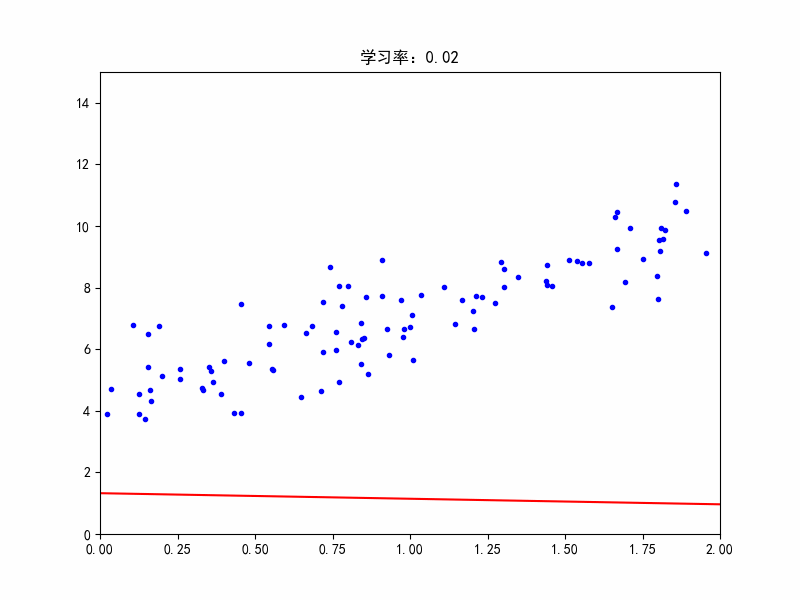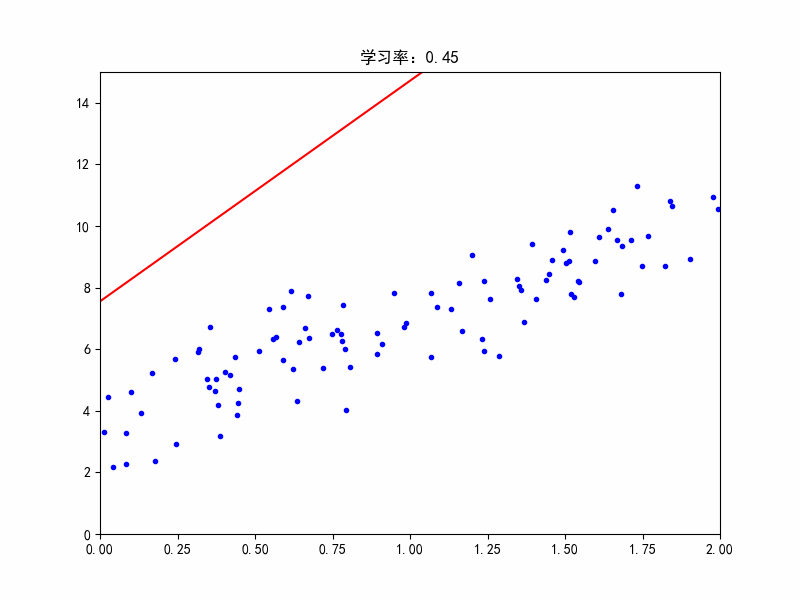- ubuntu12.04环境下使用kvm ioctl接口实现最简单的虚拟机
- Ubuntu 通过无线网络安装Ubuntu Server启动系统后连接无线网络的方法
- 在Ubuntu上搭建网桥的方法
- ubuntu 虚拟机上网方式及相关配置详解
CFSDN坚持开源创造价值,我们致力于搭建一个资源共享平台,让每一个IT人在这里找到属于你的精彩世界.
这篇CFSDN的博客文章浅谈matplotlib 绘制梯度下降求解过程由作者收集整理,如果你对这篇文章有兴趣,记得点赞哟.
机器学习过程中经常需要可视化,有助于加强对模型和参数的理解.
下面对梯度下降过程进行动图演示,可以修改不同的学习率,观看效果.
|
1
2
3
4
5
6
7
8
9
10
11
12
13
14
15
16
17
18
19
20
21
22
23
24
25
26
27
28
29
30
31
32
33
34
35
36
37
38
39
|
import
numpy as np
import
matplotlib.pyplot as plt
from
IPython
import
display
X
=
2
*
np.random.rand(
100
,
1
)
y
=
4
+
3
*
X
+
np.random.randn(
100
,
1
)
# randn正态分布
X_b
=
np.c_[np.ones((
100
,
1
)),X]
# c_行数相等,左右拼接
eta
=
0.1
# 学习率
n_iter
=
1000
# 迭代次数
m
=
100
# 样本点个数
theta
=
np.random.randn(
2
,
1
)
# 参数初始值
plt.figure(figsize
=
(
8
,
6
))
mngr
=
plt.get_current_fig_manager()
# 获取当前figure manager
mngr.window.wm_geometry(
"+520+520"
)
# 调整窗口在屏幕上弹出的位置,注意写在打开交互模式之前
# 上面固定窗口,方便screentogif定位录制,只会这种弱弱的方法
plt.ion()
# 打开交互模式
plt.rcParams[
"font.sans-serif"
]
=
"SimHei"
# 消除中文乱码
for
iter
in
range
(n_iter):
plt.cla()
# 清除原图像
gradients
=
2
/
m
*
X_b.T.dot(X_b.dot(theta)
-
y)
theta
=
theta
-
eta
*
gradients
X_new
=
np.array([[
0
],[
2
]])
X_new_b
=
np.c_[np.ones((
2
,
1
)),X_new]
y_pred
=
X_new_b.dot(theta)
plt.axis([
0
,
2
,
0
,
15
])
plt.plot(X,y,
"b."
)
plt.plot(X_new,y_pred,
"r-"
)
plt.title(
"学习率:{:.2f}"
.
format
(eta))
plt.pause(
0.3
)
# 暂停一会
display.clear_output(wait
=
True
)
# 刷新图像
plt.ioff()
# 关闭交互模式
plt.show()
|

学习率:0.1,较合适 。

学习率:0.02,收敛变慢了 。

学习率:0.45,在最佳参数附近震荡 。

学习率:0.5,不收敛 。
到此这篇关于浅谈matplotlib 绘制梯度下降求解过程的文章就介绍到这了,更多相关matplotlib 梯度下降内容请搜索我以前的文章或继续浏览下面的相关文章希望大家以后多多支持我! 。
原文链接:https://blog.csdn.net/qq_21201267/article/details/107270721 。
最后此篇关于浅谈matplotlib 绘制梯度下降求解过程的文章就讲到这里了,如果你想了解更多关于浅谈matplotlib 绘制梯度下降求解过程的内容请搜索CFSDN的文章或继续浏览相关文章,希望大家以后支持我的博客! 。
服务架构进化论 原始分布式时代 一直以来,我可能和大多数的人认知一样,认为我们的服务架构的源头是单体架构,其实不然,早在单体系
序列化和反序列化相信大家都经常听到,也都会用, 然而有些人可能不知道:.net为什么要有这个东西以及.net frameword如何为我们实现这样的机制, 在这里我也是简单谈谈我对序列化和反序列化的
内容,是网站的核心所在。要打造一个受用户和搜索引擎关注的网站,就必须从网站本身的内容抓起。在时下这个网络信息高速发展的时代,许多低质量的信息也在不断地充斥着整个网络,而搜索引擎对一些高质量的内容
从第一台计算机问世到现在计算机硬件技术已经有了很大的发展。不管是现在个人使用的PC还是公司使用的服务器。双核,四核,八核的CPU已经非常常见。这样我们可以将我们程序分摊到多个计算机CPU中去计算,在
基本概念: 浅拷贝:指对象的字段被拷贝,而字段引用的对象不会被拷贝,拷贝对象和原对象仅仅是引用名称有所不同,但是它们共用一份实体。对任何一个对象的改变,都会影响到另外一个对象。大部分的引用类型,实
.NET将原来独立的API和SDK合并到一个框架中,这对于程序开发人员非常有利。它将CryptoAPI改编进.NET的System.Security.Cryptography名字空间,使密码服务摆脱
文件与文件流的区别(自己的话): 在软件开发过程中,我们常常把文件的 “读写操作” ,与 “创造、移动、复制、删除操作” 区分开来
1. 前言 单元测试一直都是"好处大家都知道很多,但是因为种种原因没有实施起来"的一个老大难问题。具体是否应该落地单元测试,以及落地的程度, 每个项目都有自己的情况。 本篇为
事件处理 1、事件源:任何一个HTML元素(节点),body、div、button 2、事件:你的操作 &
1、什么是反射? 反射 (Reflection) 是 Java 的特征之一,它允许运行中的 Java 程序获取自身的信息,并且可以操作类或对象的内部属性。 Oracle 官方对
1、源码展示 ? 1
Java 通过JDBC获得连接以后,得到一个Connection 对象,可以从这个对象获得有关数据库管理系统的各种信息,包括数据库中的各个表,表中的各个列,数据类型,触发器,存储过程等各方面的信息。
可能大家谈到反射面部肌肉都开始抽搐了吧!因为在托管语言里面,最臭名昭著的就是反射!它的性能实在是太低了,甚至在很多时候让我们无法忍受。不过不用那么纠结了,老陈今天就来分享一下如何来优化反射!&nbs
1. 前言 最近一段时间一直在研究windows 驱动开发,简单聊聊。 对比 linux,windows 驱动无论是市面上的书籍,视频还是社区,博文以及号主,写的人很少,导
问题:ifndef/define/endif”主要目的是防止头文件的重复包含和编译 ========================================================
不知不觉.Net Core已经推出到3.1了,大多数以.Net为技术栈的公司也开始逐步的切换到了Core,从业也快3年多了,一直坚持着.不管环境
以前面试的时候经常会碰到这样的问题.,叫你写一下ArrayList.LinkedList.Vector三者之间的区别与联系:原先一直搞不明白,不知道这三者之间到底有什么区别?哎,惭愧,基础太差啊,木
目录 @RequestParam(required = true)的误区 先说结论 参数总结 @RequestParam(r
目录 FTP、FTPS 与 SFTP 简介 FTP FTPS SFTP FTP 软件的主动模式和被动模式的区别
1、Visitor Pattern 访问者模式是一种行为模式,允许任意的分离的访问者能够在管理者控制下访问所管理的元素。访问者不能改变对象的定义(但这并不是强制性的,你可以约定为允许改变)。对管

我是一名优秀的程序员,十分优秀!